Gastric Ballooning Overview
A gastric balloon is a soft, smooth, durable balloon made of silicone rubber. Placed in the stomach to reduce its capacity. Furthermore, helping individuals feel full with less food and maintain that feeling of fullness longer.
The gastric balloon procedure is a temporary, and minimally invasive option. Particularly for those looking for non-surgical procedures. To achieve the desired, weight loss surgery results in a relatively short period.
Gastric Ballooning – Eligibility and Preparation
Ideal Candidates – Body Mass Index
- A gastric balloon procedure may be a weight loss option for some adults who need the weight loss procedure or require surgery, either to lose weight before planned surgery or to assist with fertility.
- Ideal candidates include patients with a body mass index (BMI) of 30 or higher or who have a BMI of 27 or higher with at least one weight-related condition.
How Will I be Prepared for the Procedure?
For the doctor to discuss the risks the procedure can be deemed safe. They usually begin with stomach acid blockers that stop reflux after an ailment. Immediately before your stomach surgery removal procedure. The medical team put you through the liquid diet to get rid of any excess fat. The medical management will prescribe medication and also ask that you stop drinking after midnight.
Pre-Procedure Checklist
- Consult with your healthcare provider to determine just how much weight is excess weight. If you’re a good fit for the intragastric balloon system.
- Assemble a team of caregivers to support you through the program, including a nutritionist, gastroenterologist, and psychologist/psychiatrist.
- Design a personalized weight loss program with your healthcare team.
The Gastric Balloon Procedure
Placement and Removal
- Typically the procedure takes about 15 to 20 minutes. Furthermore, doctors performed it endoscopically. This procedure does not require surgery.
- The doctor uses a flexible, narrow, thin tube-like camera device. Equipped with lights, that is called an endoscope to place the balloon in the stomach.
- Then the doctor fills the the balloon with saline solution (salt water). To occupy about the size of space in the stomach. As a result, leaving less room for large amounts of food and drink.
- The balloon will place in the stomach for six months. After 6 months, the doctor will either extract or adjust the balloon using an endoscope. Depending on the weight loss progression.
What Happens During the Intragastric Balloon Procedure?
You can take some medication and you can numb it with endoscopes. Your gastroenterologist will start by looking into your esophagus or stomach using the Endoscope. Once it’s determined that the size of your balloon is safe, the balloon’s pilots will guide them to a position.
Orbera balloons contain sterile saline solutions, as most models do. Among those available outside the United States, the Obalon uses gasoline. Providers are unable to use air balloons because they are less effective overall for gaining body weight back.
What Happens During the Gastric Balloon Procedure?
It takes around 15 to 20 minutes to implant gastric balloons with endoscopes in an endoscopic clinic. The surgeon will place the balloon in the patient’s abdomen. Besides this, the medical team uses sedation so that the patient sleeps very comfortably. After the injections, the patient lies on the side and the doctors perform the surgery.

Gastric Ballooning – Post-Procedure Care and Support
Recovery Time
You will be able to go home as soon as the sedation wears off. Make sure someone can drive you.
You can resume all your normal activities without limitations, including showering, swimming, and traveling by plane.
You may experience some nausea, vomiting, or stomach cramping for a few days.
Lifestyle Coaching for Sustainable Weight Loss
Our comprehensive team approach supports your first weight loss surgery efforts with the gastric balloon. You’ll meet with our team throughout a one-year program.
After our surgeon removes the balloon. Our team will continue to work with you to help you meet your long-term lifestyle changes and weight loss goals. Our program focuses on helping individuals achieve sustainable, long-term, weight loss results. As well as a healthy lifestyle through a healthy diet and exercise habits.

Gastric Ballooning – Benefits and Results
Effective Weight Loss Solution
For the first two weeks after gastric balloon insertion. You will be on a liquid diet, followed by a gradual transition to regular food. Eventually, you are likely to lose weight quickly. Especially in the first three to four to six months, of living with the gastric balloon.
Typically, people lose about 10 to 15% of their body weight by the time the six-month program is complete.
Real-Life Examples and Research
Gastric balloons are a jump start for long-term weight loss, not a quick fix for obesity.
Many people lose more with a weight loss balloon. If they make lifestyle and diet changes while their balloon is in place. Additionally, keep up with lifestyle changes after the medical team removes the balloon.

Important Considerations
Insurance Coverage and Costs
The procedure is currently available as a self-pay option. The cost of the procedure may not be a significant amount covered by insurance. Therefore, it may be an out-of-pocket expense.
Risks and Complications
Pain and nausea affect about one-third of people after balloon placement, but symptoms usually subside within a few days.
Serious side effects are rare. But may include balloon deflation, overinflation, acute pancreatitis, ulcers, or a hole in the space inside of the stomach wall.
Gastric Balloon Side Effects
After removing the balloon, you might have nausea, vomiting, or cramps within a couple of days. Your doctor will prescribe drugs to ease the symptoms, which generally disappear within a few days.
Reflux or gastritis gastrointestinal reflux disease symptoms can be worse. Especially after doctors insert the balloon, symptoms such as discomfort or acid reflux may be improved with antacids-proton pump inhibitors (PPIs). Most patients gradually become accustomed to the presence of the balloon and are unaware of it after a few weeks, with the balloon remaining in place for about six months.
When Weight-Loss Procedures Don’t Work?
In many cases of obesity, weight loss procedures may not help you gain weight. It may be that obesity is a result of a lack of exercise and not enough nutrition. Keeping an active and regular diet and exercise is essential. Particularly, if you want to reduce obesity and the risk of regaining weight.
Gastric Ballooning – Lose Weight Safely
The gastric balloon procedure is a safe and effective way for patients to lose weight and achieve a healthier lifestyle.
With the diet and exercise plan, and the support of a comprehensive health care team. As well as the commitment to making lifestyle changes. Evidently, you can achieve significant weight loss and maintain it over time.
Call us or schedule a teleconsultation to inquire further about gastric balloon procedure details and pricing. Moreover, we offer both gastric balloon placement and intragastric balloon placement.

Gastric Ballooning – Orbera vs. Spatz3 Gastric Balloon
Since the first gastric balloon implantation in 1985, the FDA has approved four different types of gastric balloons, giving patients a range of options, including Orbera, Spatz, ReShape, and Obalon. If you’re torn between choosing the Orbera and Spatz3 gastric balloon procedures. Then the insights will help you compare both options in detail, allowing you to make an informed decision.
What Is an Orbera Balloon?
The Orbera gastric balloon is an intragastric device designed to help individuals with heavier body weight. This non-surgical procedure involves placing a soft silicone balloon inside the stomach and filling it with saline. The balloon takes up space in the stomach, helping patients feel full even after consuming smaller portions of food. Orbera balloons remain in the stomach for six months, aiding in weight loss by promoting portion control and encouraging healthier dietary habits.
What Is a Spatz3 Balloon?
Similarly, doctors place a Spatz3 gastric balloon in the stomach and filled with saline to create a feeling of fullness. This sensation helps patients eat less and lose weight over time. However, what sets the Spatz3 apart is its adjustability. The doctors can modify the balloon’s volume as needed. Besides this, it can remain in the stomach for up to 12 months, depending on the regulatory approvals in your country.
Gastric Ballooning – Key Differences Between Orbera and Spatz3 Balloon
Balloon Design and Placement
The Orbera balloon is a single-use device that doctors insert into the stomach endoscopically. The procedure, which takes about 20 minutes, doesn’t require anesthesia or incisions. Once the six-month treatment period ends. Then doctors remove the balloon using the same endoscopic method. However, doctors cannot adjust the size of the Orbera balloon after placement. Despite this, the Orbera balloon has been recognized as “the ideal balloon” by international experts due to its smooth design.
In contrast, the Spatz3 balloon features a unique free-floating tail attached to the silicone balloon. This tail includes an extension tube that allows doctors to adjust the balloon’s volume during treatment. This adjustability eliminates the need for additional procedures to replace the balloon and makes it easier to tailor the treatment to the patient’s weight loss goals or stomach capacity.
Gastric Balloon Volume
The Orbera balloon has a fixed volume, typically ranging from 300 to 700 ml, which is set during placement based on the patient’s stomach capacity. Once inflated, the volume remains constant throughout the six months.
On the other hand, the Spatz3 balloon offers a variable volume ranging from 300 to 900 ml. Doctors can increase or decrease the balloon’s size at any point during its 12-month lifespan, allowing for more personalized treatment and potentially reducing side effects.
Weight Loss Results
Both the Orbera and Spatz3 gastric balloons have been proven effective in promoting significant weight loss. Clinical studies show that the Orbera balloon can help patients lose an average of 15.4% of their total body weight. Similarly, the Spatz3 balloon achieves an average weight loss of 15.5% of total body weight. However, these results can vary based on individual factors such as lifestyle changes and commitment to behavior modification.
Side Effects
Both balloons carry certain risks, though serious complications are rare. Common side effects include temporary discomfort, nausea, vomiting, and abdominal pain. In severe cases, the balloon could rupture or cause a bowel obstruction, requiring immediate medical attention. Regular follow-up appointments with your doctor are crucial to minimize potential risks during the treatment period.
Cost and Availability
The cost of both balloons typically ranges from $6,000 to $9,000, depending on factors such as location, individual circumstances, and the expertise of the healthcare provider. These procedures are generally more affordable than bariatric surgeries.
In terms of availability, the Orbera balloon has been on the market since 2015 and is widely used in Europe and the United States. It served as a foundational design for other gastric balloons, including the Spatz3. The Spatz3 balloon, however, was only recently approved by the FDA in 2021. Making it a newer and innovative weight loss solution with more limited availability in certain regions.
Which One Is Right for You?
The Spatz3 Adjustable Gastric Balloon by Spatz Medical stands out for its adjustability and longer treatment duration, making it a more versatile option for many patients. However, the best choice ultimately depends on your specific weight loss goals and medical circumstances. Consulting with your doctor is essential to determine which balloon will best suit your needs.
Gastric balloons have become increasingly popular as affordable and effective alternatives to bariatric surgery. When deciding between the Orbera and Spatz3 gastric balloons, it’s important to consider both the similarities and differences. The key to making an informed decision lies in understanding your unique requirements and weight loss objectives.











